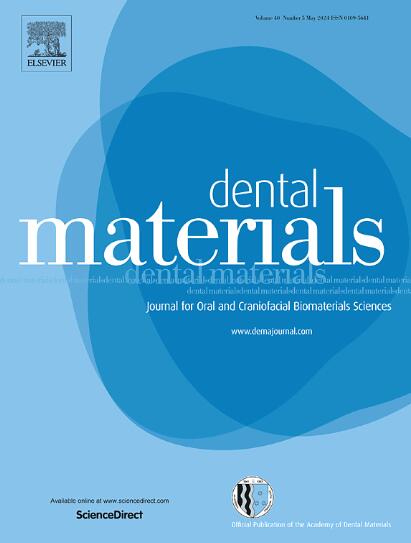打印方向和石墨烯纳米片对用于咬合夹板的可三维打印树脂的双轴抗弯强度和细胞毒性的影响。
IF 4.6
1区 医学
Q1 DENTISTRY, ORAL SURGERY & MEDICINE
引用次数: 0
摘要
目的:三维打印技术已进入各种医疗应用领域,对牙科尤其有益。目前,与用于咬合夹板标准铣削的聚甲基丙烯酸甲酯(PMMA)相比,用于三维打印咬合夹板的材料缺乏机械强度。众所周知,打印取向和石墨烯纳米板(GNP)可以提高各种材料的双轴强度。因此,本研究旨在评估调整打印方向和添加 GNP 是否能提高双轴强度,以及是否会影响用于咬合夹板的 3D 打印树脂的细胞毒性:方法:使用立体光刻(SLA)打印机垂直和水平打印试样,并在树脂中添加不同浓度的多层 GNP 粉末。通过拉曼光谱、光学轮廓仪分析和扫描电子显微镜对打印试样进行表征。通过双轴弯曲测试评估了双轴强度。试样对 L929 和牙龈基质细胞(GSC)的细胞毒性通过毒牙试验、基于利马嗪的毒性检测和活死细胞染色进行了评估:结果:水平印刷的试样显示出明显更高的双轴强度和更低的变形。GNP 没有改善三维打印树脂的双轴强度和材料变形。所有试样都不会对 L929 细胞或 GSC 产生细胞毒性:SLA打印中的打印方向对双轴强度和材料变形有重大影响。在使用最佳打印方向时,3D打印材料的双轴强度与PMMA相当甚至更高,而GNP对3D打印咬合夹板树脂的双轴强度没有好处。本文章由计算机程序翻译,如有差异,请以英文原文为准。
The impact of print orientation and graphene nanoplatelets on biaxial flexural strength and cytotoxicity of a 3D printable resin for occlusal splints
Objectives
3D printing found its way into various medical applications and could be particularly beneficial for dentistry. Currently, materials for 3D printing of occlusal splints lack mechanical strength compared to polymethyl methacrylate (PMMA) used for standard milling of occlusal splints. It is known that print orientation and graphene nanoplatelets (GNP) can increase biaxial strength in a variety of materials. Thus, the aim of this study was to assess if adjustment of print orientation and addition of GNP improve biaxial strength and if they affect cytotoxicity of a 3D printable resin for occlusal splints.
Methods
Specimens were printed vertically and horizontally with a stereolithography (SLA) printer and multilayered GNP powder was added to the resin at different concentrations. Printed specimens were characterized by Raman spectroscopy, optical profilometer analysis and scanning electron microscopy. Biaxial strength was evaluated by biaxial flexural testing. Cytotoxicity of specimens on L929 and gingival stromal cells (GSC) was assessed by the toxdent test, the resazurin-based toxicity assay and live-dead staining.
Results
Horizontally printed specimens showed significantly higher biaxial strength and lower deformation. GNP did not improve biaxial strength and material deformation of 3D-printed resins. None of the specimens were cytotoxic to L929 cells or GSC.
Significance
Print orientation in SLA printing has a significant impact on biaxial strength and material deformation. 3D printable materials can reach comparable or even improved biaxial strength compared to PMMA when using the optimal print orientation while GNP has no beneficial effects on the biaxial strength of resins for 3D printing of occlusal splints.
求助全文
通过发布文献求助,成功后即可免费获取论文全文。
去求助
来源期刊

Dental Materials
工程技术-材料科学:生物材料
CiteScore
9.80
自引率
10.00%
发文量
290
审稿时长
67 days
期刊介绍:
Dental Materials publishes original research, review articles, and short communications.
Academy of Dental Materials members click here to register for free access to Dental Materials online.
The principal aim of Dental Materials is to promote rapid communication of scientific information between academia, industry, and the dental practitioner. Original Manuscripts on clinical and laboratory research of basic and applied character which focus on the properties or performance of dental materials or the reaction of host tissues to materials are given priority publication. Other acceptable topics include application technology in clinical dentistry and dental laboratory technology.
Comprehensive reviews and editorial commentaries on pertinent subjects will be considered.
 求助内容:
求助内容: 应助结果提醒方式:
应助结果提醒方式:


